27 April 2018 by Chris Cathrine | Comments: 0
Share this article:

On 17th March 2018, Director Chris Cathrine presented the results of Site Condition Monitoring invertebrate surveys at Sites of Special Scientific Interest (SSSIs) in Tayside, at the Tayside Recorders’ Day, in Perth. Some of the results of these surveys, completed between 2011 and 2017 under contract to Scottish Natural Heritage (SNH), have not been made publicly available before, other than as records on NBN Atlas.
Caledonian Conservation Ltd has completed Site Condition Monitoring of invertebrate features for 56 SSSIs in Scotland between 2011 and 2017 under contract SNH. Of these SSSIs, five were located in Tayside: Barry Links (2011), Black Wood of Rannoch (2013), Den of Airlie (2015), Dollar Glen (2013), and Methven Woods (2015).
Among the stand out finds were the rediscover of the extinct flutter-wing fly Palloptera laetabilis and finding other rare invertebrate such as the lichen running-spider (Philodromus margaritatus).
The conference presentation and article in the Tayside Recorders’ Bulleting which includes the conference proceedings can be downloaded via the Caledonian Conservation Ltd publications page.
For more information about Tayside Biodiversity Partnership, who organised the conference, please visit: http://www.taysidebiodiversity.co.uk/
For more information about SNH and their work, please visit: https://www.nature.scot/
Photo: The lichen running-spider (Philodromus margaritatus) - one of the rare species found during surveys of SSSIs in Tayside.
23 January 2018 by Chris Cathrine | Comments: 0
Share this article:
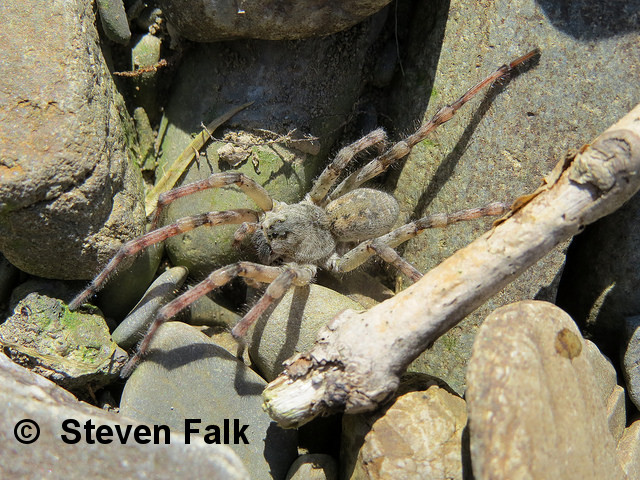
While surveying for flies and butterflies during Site Condition Monitoring at Morrich More Site of Special Scientific Interest (SSSI) in 2015, Director Chris Cathrine made a surprising discovery when a big female Northern bear sider (Arctosa cinerea) ran on to his sweep net!
This is not only the most northerly record for the Northern bear spider in the UK, but is also the first documented example of the species using sandy habitats – in this case on a stabilised dune system. Although it has been found to use this habitat for some parts of its life cycle in Europe, it is typically found under stones in shingle in the UK.
You can read more about this discovery in an article in the latest issue of the latest issue of the Newsletter of the British Arachnological Society. The article is also available to read here, via the Caledonian Conservation Ltd publications page.
The Site Condition Monitoring surveys at Morrich More SSSI were completed under contract to Scottish Natural Heritage (SNH). For more information about SNH and their work, please visit: https://www.nature.scot/
For more information about the Newsletter of the British Arachnological Society and the British Arachnological Society in general, please visit: www.britishspiders.org.uk
Photo: Arctosa cinerea © Steven Falk. For more information on Steven Falk’s work and photography, please visit: http://www.stevenfalk.co.uk/
15 November 2017 by Chris Cathrine | Comments: 0
Share this article:
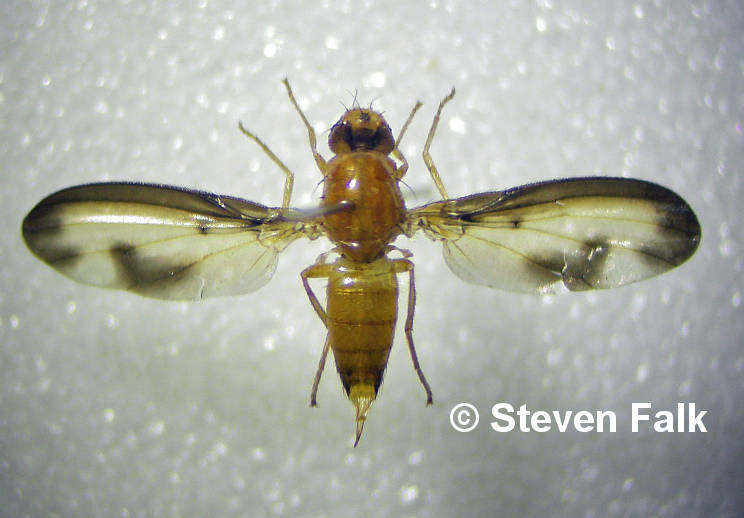
A rare flutter-wing fly, Palloptera laetabilis, not seen in the UK for over 100 years has been found at Den of Airlie Site of Special Scientific Interest (SSSI), a woodland in Angus. This is also the first time this fly has ever been found in Scotland.
The rare fly was presumed to be extinct, but was found during site condition monitoring surveys completed by Caledonian Conservation under contract to Scottish Natural Heritage (SNH) in 2015. The discovery has since been confirmed and published by Steven Falk (the fly expert on the project team) in the most recent issue of Dipterists Digest.
Den of Airlie SSSI is only the fifth site that this species has been recorded at in the UK, and the only one in Scotland. The other four sites are all located in England, with the last record being from Oxfordshire in 1907.
Chris Cathrine, Director of Caledonian Conservation and project leader for the 2015 invertebrate site condition monitoring project said: “Finding a species last recorded over a century ago is very exciting. That this is also the first record for the species in Scotland makes this all the more special. We found a great number of rare species during our surveys across Scotland. While Palloptera laetabilis is undoubtedly the most exciting, we hope to publish records from all 25 sites, including the Isle of Rum, in the future.”
The invertebrate records collected by Caledonian Conservation during these surveys (including Den of Airlie SSSI) are available on NBN Atlas at: https://registry.nbnatlas.org/public/show/dp4
Learn more about SNH’s work in Scotland at: http://www.snh.gov.uk/
Steven Falk’s paper on Palloptera laetabilis is available on the Caledonian Conservation publications page, or directly here.
Steven Falk was contracted by Caledonian Conservation to complete surveys for this project through his previous role at Buglife – the Invertebrate Conservation Trust. For more information on Steven Falk’s work and photography, please visit: http://www.stevenfalk.co.uk/
For more information about the Dipterists Digest visit: http://www.dipteristsforum.org.uk/sgb_dipterists_digest.php
Photo: Female Palloptera laetabilis from Den of Airlie Site of Special Scientific Interest (SSSI) © Steven Falk
23 August 2017 by Chris Cathrine | Comments: 0
Share this article:
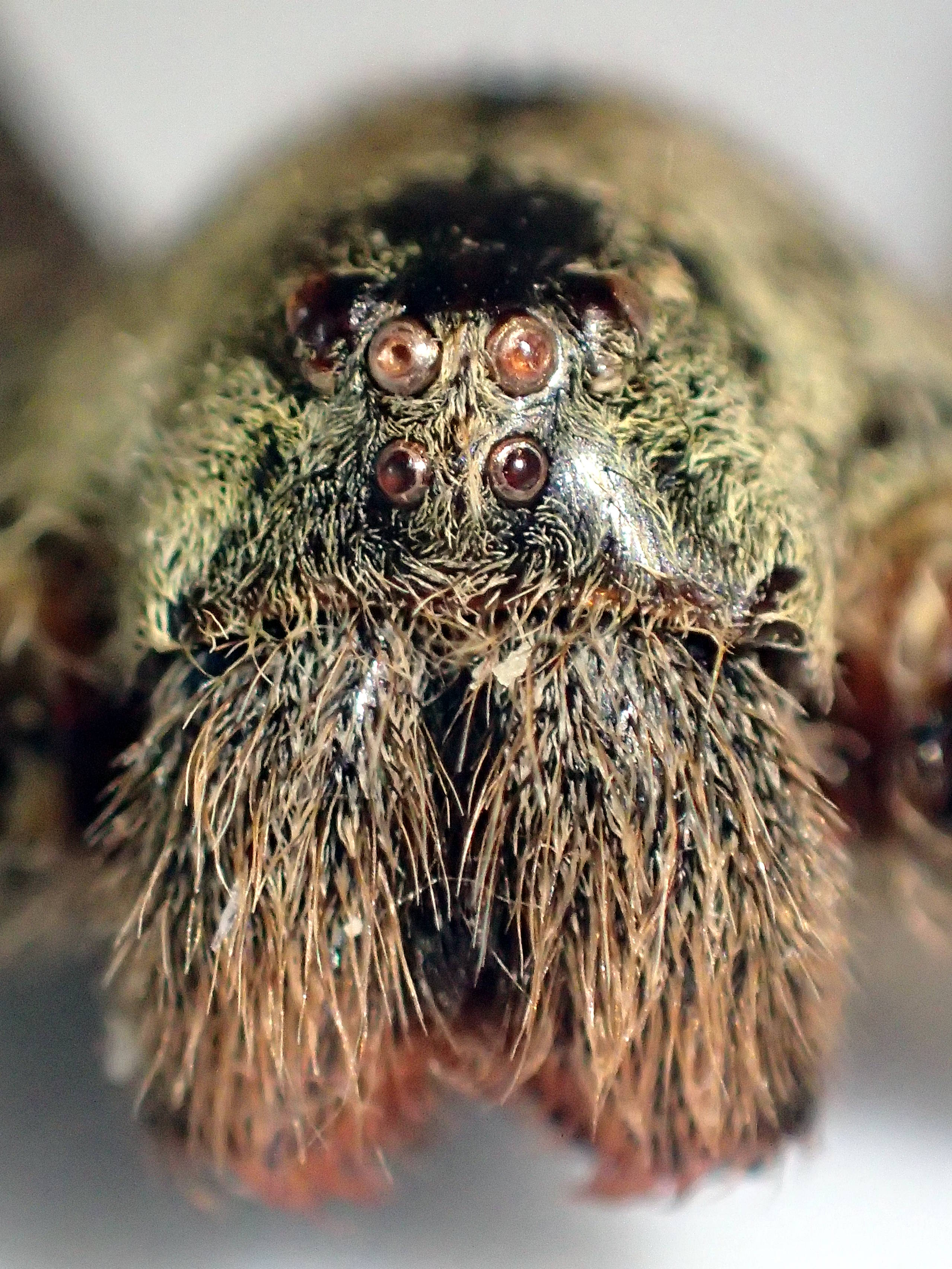
Caledonian Conservation’s Director, Chris Cathrine, co-authored an article with Stuart Longhorn for The Newsletter of the British Arachnological Society describing a specimen of Phoneutria (P. cf. boliviensis) which was found in Inverbervie (Aberdeenshire) in a banana shipment from Colombia in 2016. SRUC later sent the spider to Caledonian Conservation for identification.
The article was published on 14th August 2017, and provides information on the record, as well as photos and a diagram of the epigyne (female genitals, unique to the species of spider).
With relatively little information published on the identification of Phoneutria (known as ‘wandering spiders’ and belonging to the family Ctenidae, which does not occur naturally in the UK), there was an opportunity to share useful identification details with ecologists working throughout the world. We are proud that the article was quickly added to the World Spider Catalogue – a resource that collates key taxonomic literature on spiders, for use by academic researchers and other ecologists throughout the world.
Despite frequent media reports claiming Phoneutria spiders (sometimes erroneously referred to by the press as ‘painful erection death spiders’) to have been found in the UK and often indicating they are associated with damaging bites to people, there are no previous records published in scientific literature. These reports are rarely substantiated, and the specimens are not normally identified by expert arachnologists. Given the claims of medically important bites, Chris and Stuart felt it would be helpful to describe the effects of the venom of different Phoneutria species based on peer reviewed literature in the article.
It is hoped that this article will help inform a more robust understanding of the occurrence of Phoneutria spiders in the UK, help others identify these species, and be a useful reference source for journalists reporting on wandering spiders in the future.
The article is available to download on the Caledonian Conservation publications page and the World Spider Catalogue.
Learn more about the British Arachnological Society here.
The World Spider Catalogue is hosted by the Natural History Museum of Bern, and more information can be found here.
08 May 2017 by Chris Cathrine | Comments: 0
Share this article:
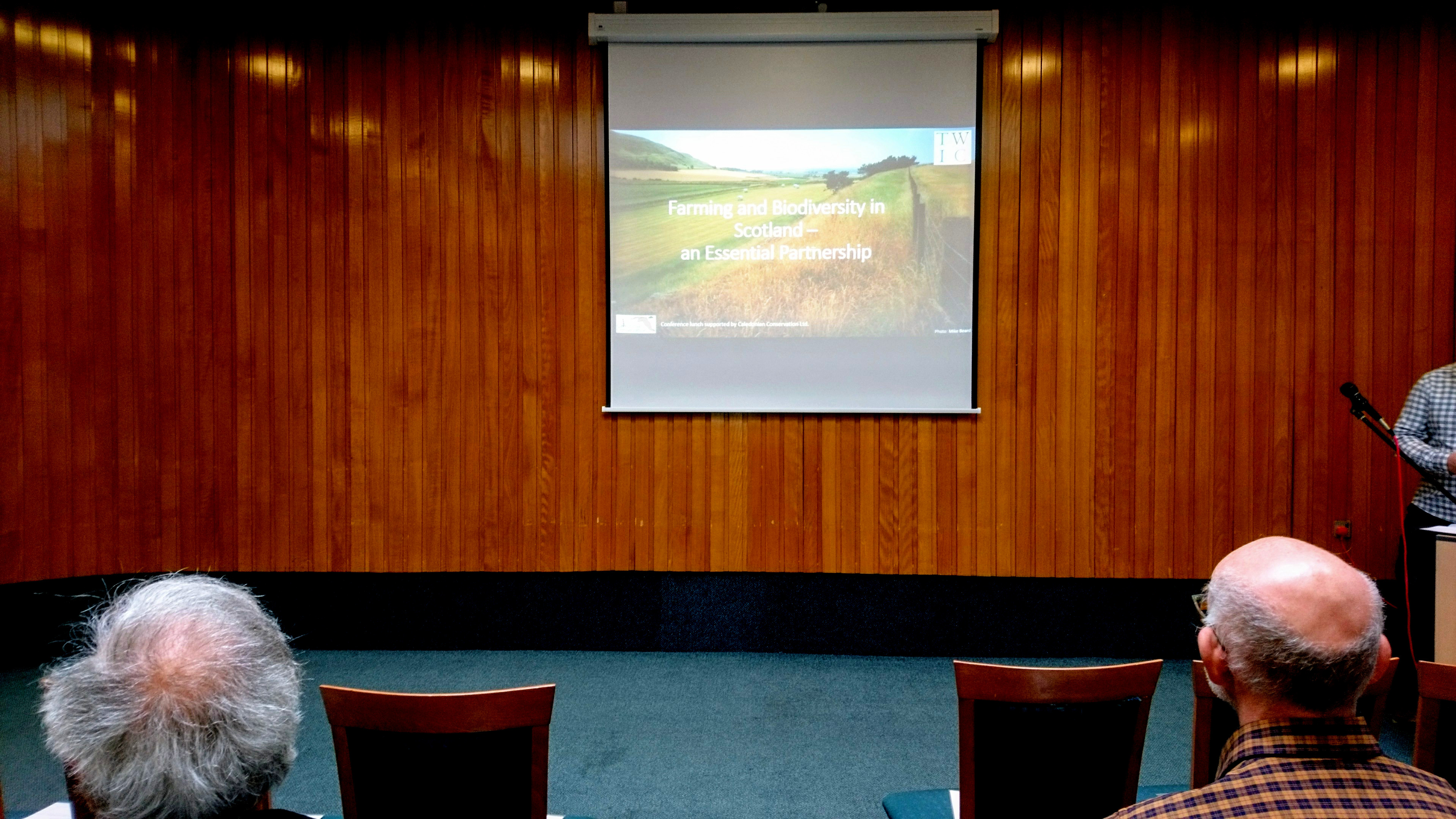
Caledonian Conservation sponsored The Wildlife Information Centre (TWIC) Spring Conference ‘Farming and Biodiversity in Scotland – An Essential Partnership’ at Musselburgh on Saturday 29th April. Niall Currie (Assistant Ecologist) reports...
The event was very well attended and allowed farmers, land managers, ecologists and biological recorders to meet and exchange ideas. The excellent range of topics varied from the experience of individual farmers carrying out conservation projects on their farms, to global issues such as planning how best to manage soils and the incredibly complex ecological communities they support.
Other talks included individual species conservation projects, such as the Game and Wildlife Conservation Trust’s research into improving the survival prospects of grey partridge (Perdix perdix) on farms by increasing vegetation cover during the breeding season and over winter.
The break for lunch, gave attendees the opportunity to explore stands and learn about TWIC’s latest citizen science project - the Scottish Spider Search - which Caledonian Conservation has helped to develop in partnership with the British Arachnological Society and Buglife.
The afternoon session included an update from Pete Minting (Amphibian and Reptile Conservation Trust) on the exciting ‘Great Crested Newt Detectives Project’, which has been trialing new methods of using DNA samples of pond water to determine whether great crested newts, and to which Caledonian Conservation has also contributed by surveying remote ponds and providing control samples from known sites.
The conference was a great success, being the largest arranged by TWIC to date, and a ‘sell out’ (although Caledonian Conservation’s sponsorship allowed the conference to be free to attend).
13 April 2017 by Chris Cathrine | Comments: 0
Share this article:
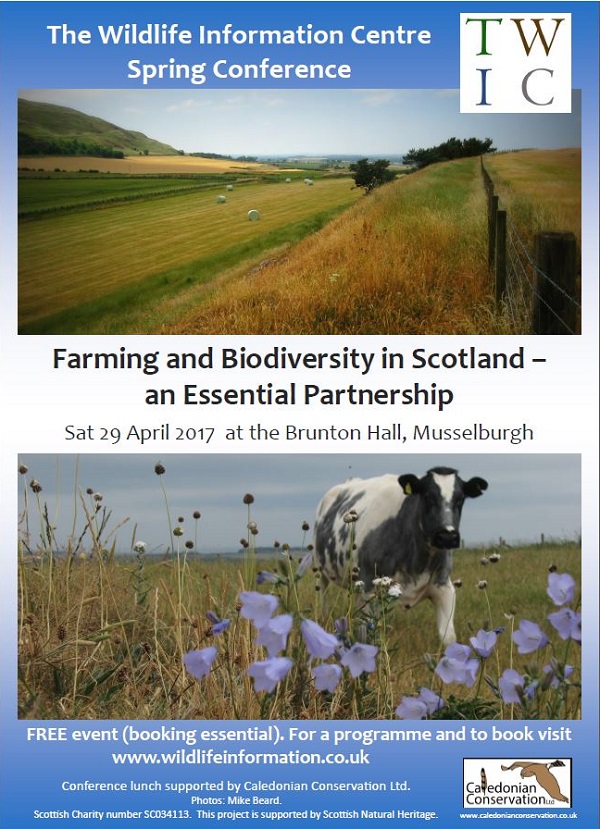
Caledonian Conservation Ltd is proud to sponsor The Wildlife Information Centre (TWIC) 2017 Spring Conference, to be held in Musselburgh on 29th April. The topic, Farming and Biodiversity, is always important but is brought in to sharper focus with the uncertainty created by Brexit.
Farming and biodiversity are an essential partnership – farming cannot succeed without the ecosystem services necessary to support it, such as pollination (by wild solitary bees, bumblebees, beetles, flies, butterflies and moths as well as domesticated honey bees), soil creation and recycling (by a variety of worms, springtails, symphylans, fungi – the list goes on!), clean water and natural pest control. Farming can also offer excellent opportunities to support biodiversity, for example birds (breeding habitat for farmland bird species, nesting opportunities for owls, foraging habitat for raptors and owls), mammals (foraging and roosting opportunities for bats), reptiles (hibernation sites in walls and foraging opportunities in field margins), amphibians (ponds and a mix of farmland habitats can be excellent for great crested newts), invertebrates and plants.
Reflecting this, the conference has a superb and varied programme with talks on soil communities (by Dr Tim Daniell of University of Sheffield / The James Hutton Institute), grey partridge conservation (by Fiona Torrance of The Game and Wildlife Conservation Trust) and great crested newts (by Pete Minting of Amphibian and Reptile Conservation Trust) amongst other topics.
Of course, members of the Caledonian Conservation Ltd team will also be at the conference, so it is an opportunity to learn more about the work we do.
The conference is free to attend, and includes a buffet lunch.
For more information on the programme and to book, visit the TWIC website.
We hope to see you there!
11 April 2017 by Chris Cathrine | Comments: 0
Share this article:
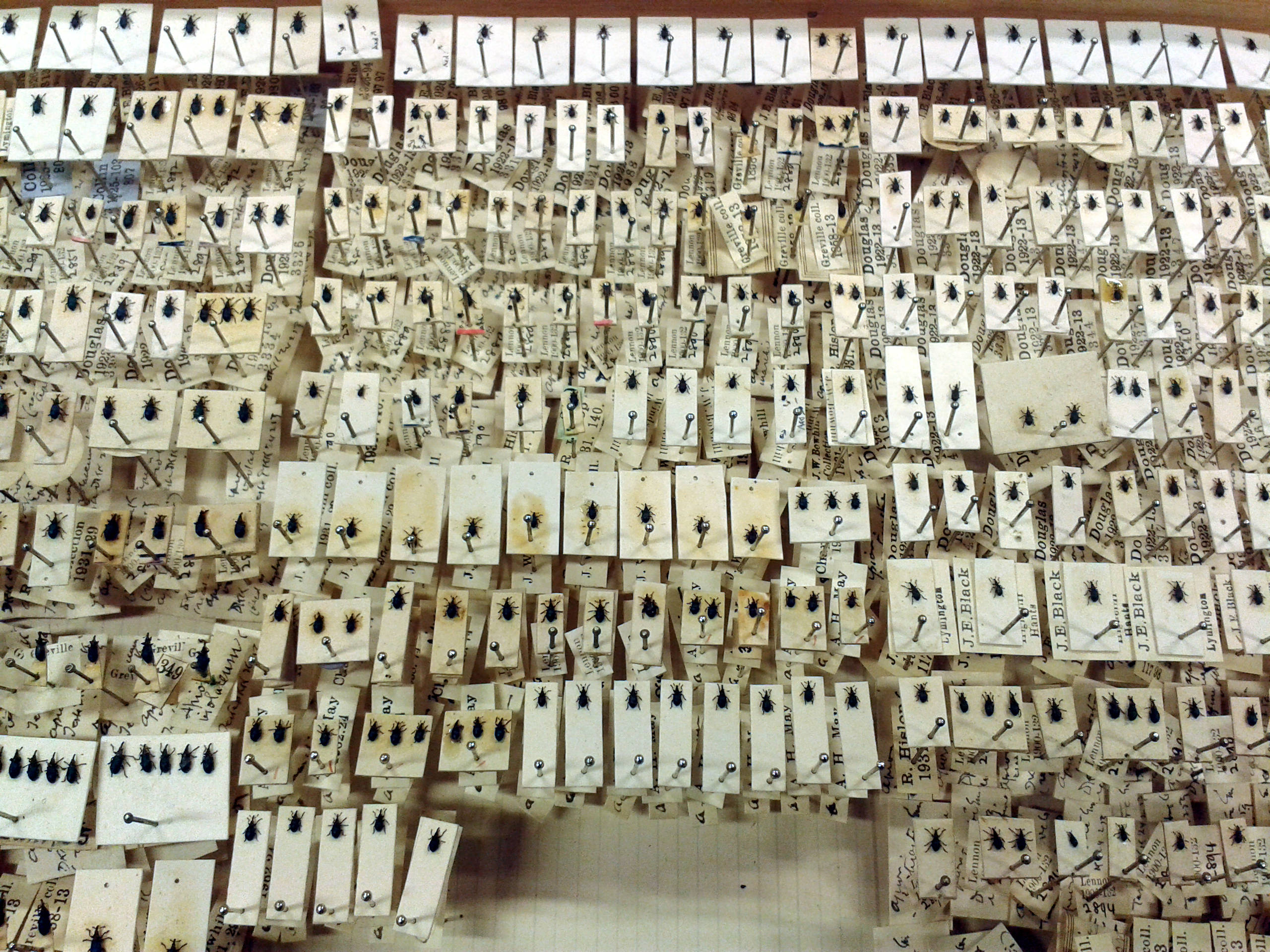
In September 2016, Director Chris Cathrine carried out invertebrate surveys at Scottish Wildlife Trust’s (SWT) Balgavies Loch reserve using Caledonian Conservation’s bugvac (a modified leaf blower that sucks bugs into a net). Bugvac is excellent at turning up invertebrates such as spiders and beetles hiding deep within vegetation that would be difficult to collect or missed entirely using traditional collection methods. Recently we identified the species collected, however some of these invertebrates can be very difficult to differentiate from one another, even using the microscopes, identification keys and reference collections we have in the office.
Luckily the National Museum of Scotland Collection Centre in Edinburgh allows access to their collections for reference and research, giving us the opportunity to compare anatomical features of our samples against curated specimens in the collection. In Britain there are around 4,000 known beetle species and, just like people, individuals of each species are unique, coming in a natural range of shapes, colours and sizes. Around a quarter of all beetles are members of the Staphylinidae family (rove beetles), many of which show only very minute physicals differences from one another. A good reference collection with a number of specimens of the same species collected from different geographical locations can prove very useful in aiding identification.
Despite the difficulty of identifying some species, the information gained can be very useful for making informed decisions about changes to land management. Since many invertebrate species require very specific microhabitats or host plants, they are often excellent indicators of habitat quality and change. The conservation status and habitat preferences of the species identified in different parts of Balgavies Loch reserve will help SWT plan how the site can be best managed for a wide range of wildlife in the future.
Check out National Museum of Scotland’s website for more information about their excellent resources.
The SWT Balgavies Loch invertebrate report is also available to read via the Caledonian Conservation Ltd website, here.
Visit SWT's website to learn more about Balgavies Loch and their other reserves.
12 December 2016 by Chris Cathrine | Comments: 0
Share this article:
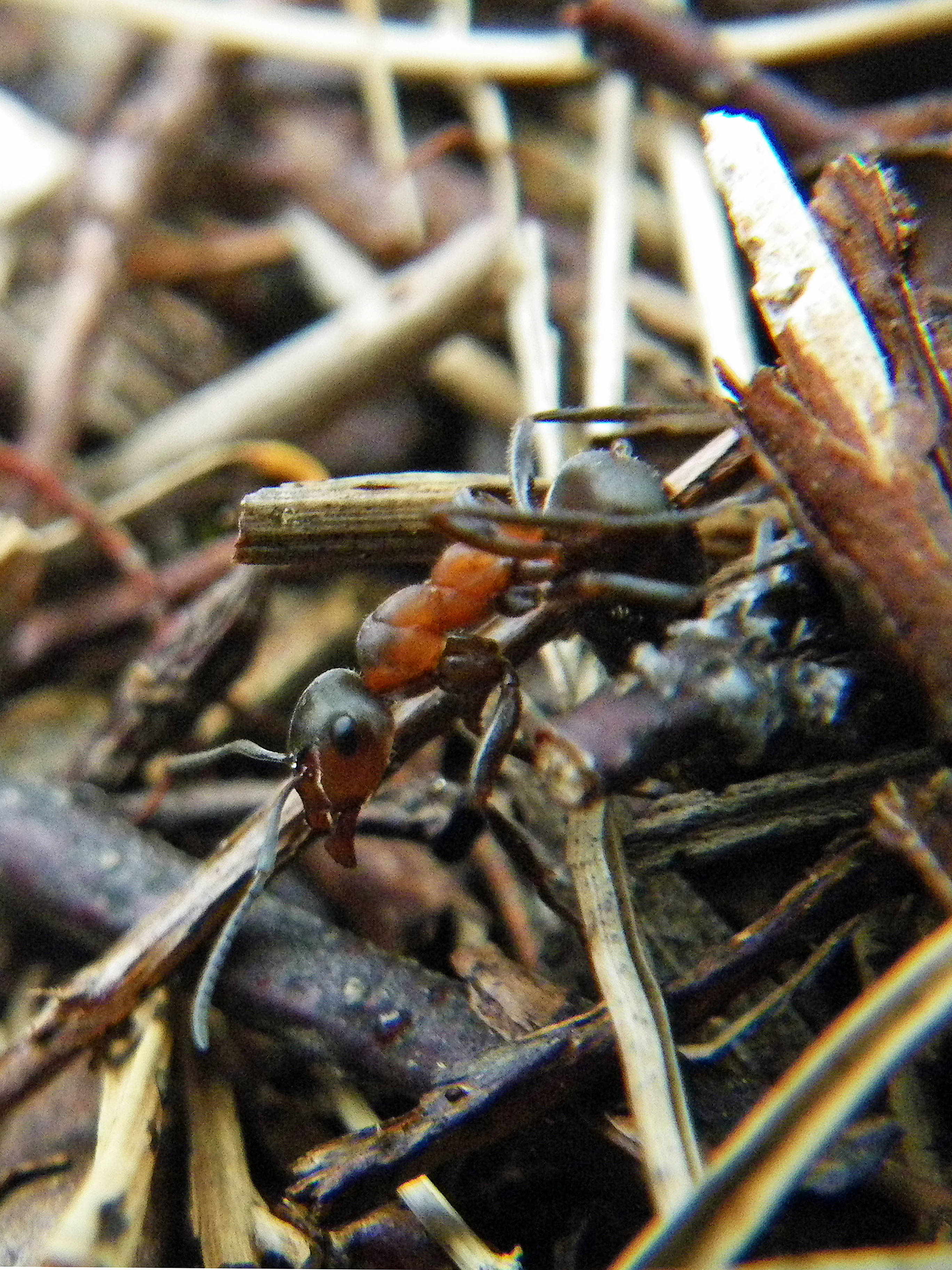
At Caledonian Conservation we aim to benefit people and wildlife. To achieve this, we feel it is essential to share our experiences with other professional and academic ecologists to help improve best practice (within legal and commercial restrictions). This includes presenting articles in the Chartered Institute of Ecology and Environmental Management (CIEEM) In Practice publication, which is distributed to the organisation’s membership. Director Chris Cathrine has been an author of four articles in this publication, and we are pleased that we are now able to offer these publicly on the Caledonian Conservation Ltd website. These articles include:
Cathrine, C. 2015. Wood Ant Nest Translocations. In Practice 89, 14-18.
Cathrine, C. and Amphlett, A. 2011. Deadwood: Importance and Management. In Practice 73, 11-15.
To explore other publications, research posters and conference papers, go to the Caledonian Conservation publications page.
To learn more about the Chartered Institute of Ecology and Environmental Management, visit their website.
05 December 2016 by Chris Cathrine | Comments: 0
Share this article:

We’re very pleased that BBC chose to use a Caledonian Conservation photo of a frosty hairy wood ant (Formica lugubris) nest in a gallery illustrating frozen Scotland: http://www.bbc.co.uk/news/uk-scotland-38136716
Wood ant nests are masterworks of eco-architecture and sustainable design, taking maximum advantage of renewable energy and local resources. Wood ant nests are built around a tussock of grass, soil or another feature, which provides a source of heat through decay of vegetation as well as a foundation. Constructed so that the south facing side is larger and flatter to capture solar energy and allow workers to bask, before returning to brood chambers where they act as storage heaters. Finally, the thatched roof made from pine needles, heather and grass provides excellent insulation.
There are four species of wood ants (including close relatives) in Scotland: the hairy wood ant, Scottish wood ant (Formica aquilonia), slave-maker ant (Formica sanguinea) and narrow-headed ant (Formica exsecta). These species have different habitat preferences, and perform a range of important ecosystem services. Caledonian Conservation has wood ant expertise, and you can read about our nest translocation work for developments and Site Condition Monitoring surveys for Scottish Natural Heritage (SNH) on our publications page. Caledonian Conservation Director Chris Cathrine is also a member of the UK National Wood Ant Steering Group.
To learn more about wood ants in the UK, visit the website of the National Wood Ant Steering Group.
An excellent book on wood ants has also recently been published, and is highly recommended:
20 November 2016 by Chris Cathrine | Comments: 0
Share this article:
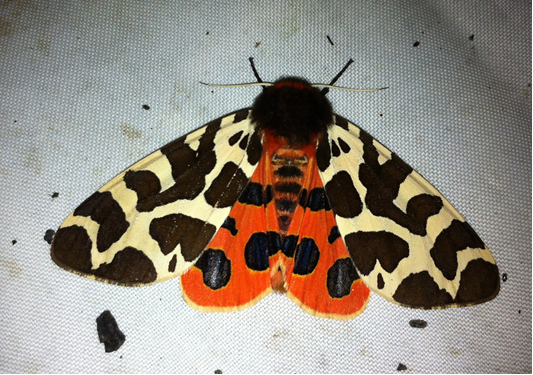
Caledonian Conservation Ltd had completed several surveys for Scottish Wildlife Trust (SWT) since the company was formed in 2010. These surveys have included protected mammals, bryophytes and invertebrates (terrestrial and aquatic). Both Caledonian Conservation Ltd and SWT share a commitment to making as much of our work available publicly (within legal constraints), and we are pleased to publish three historic reports online. You can download these, and other documents, from the Caledonian Conservation Ltd publications page.
The reports include:
Jupiter Urban Wildlife Centre bryophyte survey (2010): 24 species of bryophytes were recorded, and interpretation notes and habitat management recommendations are included in the report.
Jupiter Urban Wildlife Centre water vole survey (2010): no water voles were found, and habitat was considered sub-optimal, however habitat management recommendations are included in the report.
Cathkin Marsh invertebrate survey (2013): the survey included terrestrial and aquatic invertebrates and 201 species were recorded, including Northern arches moth (Apamea zeta - Nationally Scarce) and garden tiger moth (Arctia caja - Scottish Biodiversity List). Interpretation notes and habitat management recommendations are also included in the report.